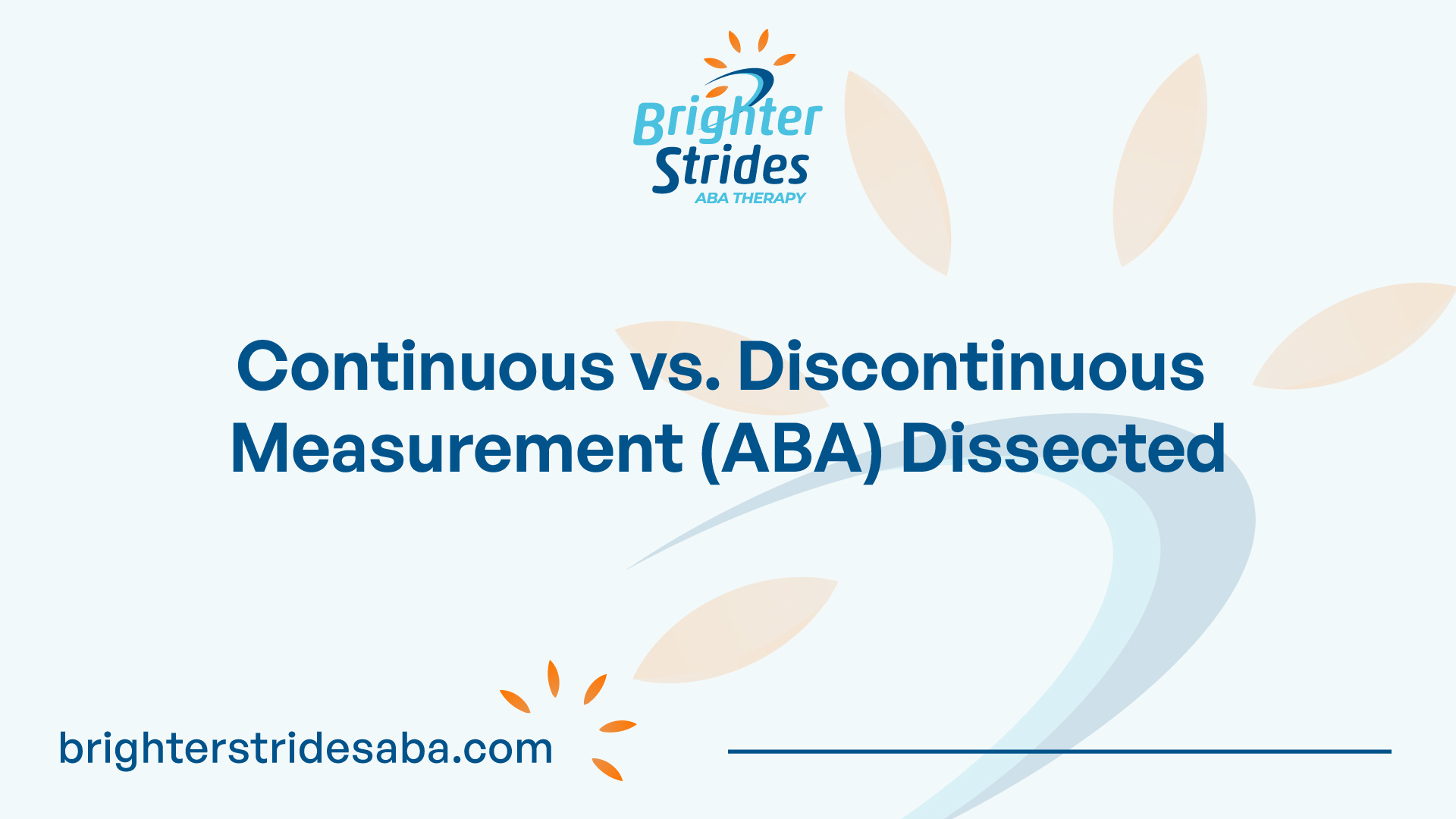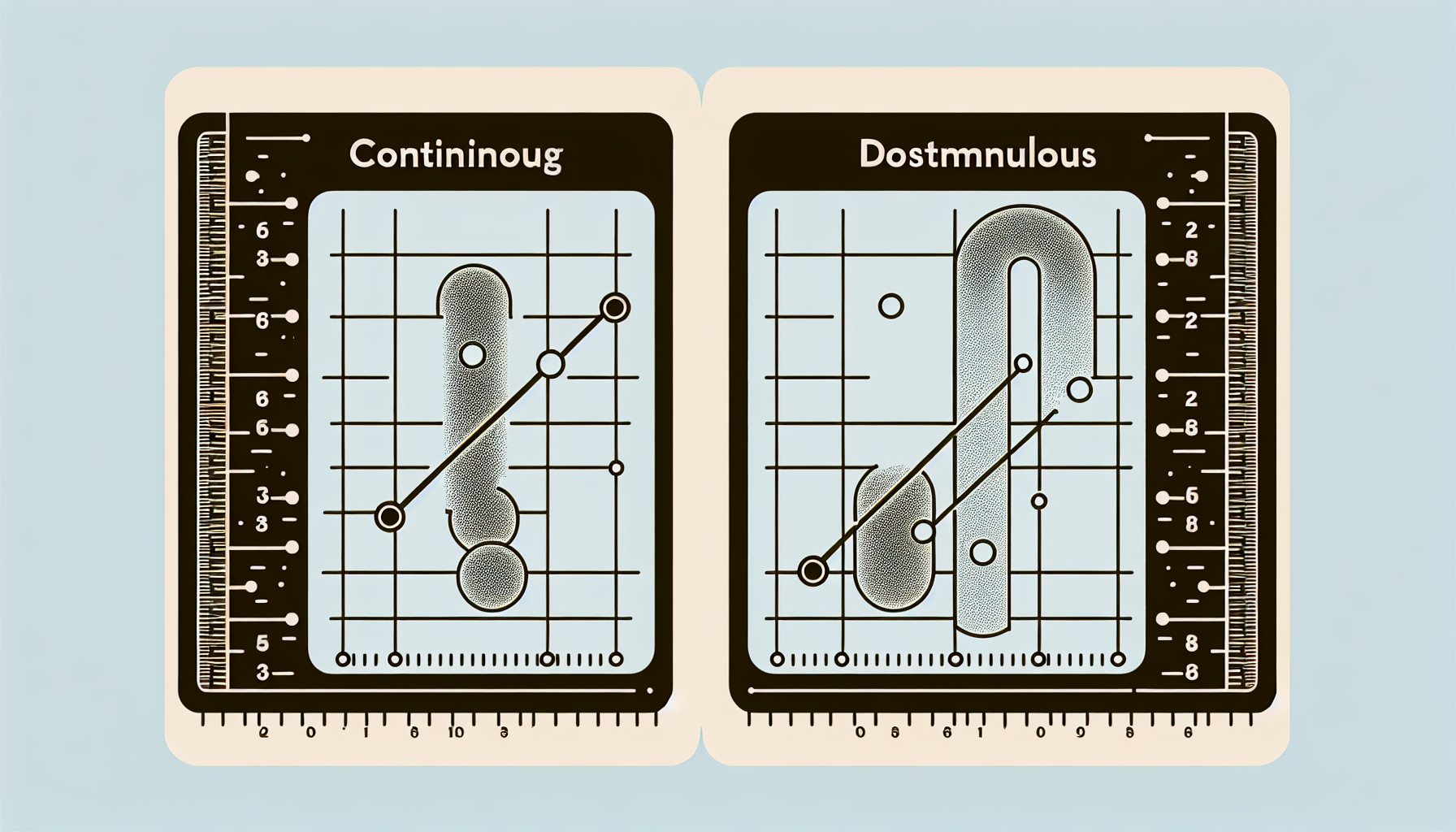Understanding Measurement in ABA
Measurement plays a crucial role in Applied Behavior Analysis (ABA) as it allows for the systematic and objective assessment of behavior. In ABA, data is categorized into two types: continuous and discontinuous measurement. Let’s explore the difference between these two measurement approaches and understand their importance in ABA.

Continuous vs. Discontinuous Measurement
Continuous measurement involves observing and recording behavior data continuously within a given period. This method tracks the behavior in real-time, ensuring that no instances go unnoticed. It is particularly beneficial when the behavior being measured occurs at a high frequency or has a long duration, providing a comprehensive and detailed understanding of behavior occurrence and patterns. Continuous measurement allows for the analysis of various aspects of behavior, such as frequency, duration, and intensity.
On the other hand, discontinuous measurement involves recording data during specific intervals. This method samples behavior at predetermined time intervals, providing a snapshot of behavior occurrence within those intervals. Discontinuous measurement is often used when continuous measurement is not feasible or practical due to limited resources or when the behavior occurs at a low frequency.
Importance of Measurement in ABA
Measurement is of utmost importance in ABA as it allows for accurate and objective assessment of behavior change over time. It provides data that can be analyzed and used to make informed decisions regarding treatment strategies and interventions. By measuring behavior, ABA practitioners can track progress, identify patterns, and make necessary adjustments to the intervention plans.
Measurement also helps in evaluating the effectiveness of interventions and determining whether the desired behavioral changes are occurring. It allows for the identification of trends, the assessment of treatment fidelity, and the evaluation of the overall effectiveness of the intervention program.
In summary, continuous and discontinuous measurement are two approaches used in ABA to gather data on behavior. Continuous measurement provides a detailed understanding of behavior occurrence and patterns, while discontinuous measurement samples behavior within specific intervals. Both approaches are essential in ABA as they contribute to the systematic analysis and evaluation of behavior change.
Continuous Measurement Methods
When it comes to measuring behavior in Applied Behavior Analysis (ABA), continuous measurement methods are employed to gather accurate and detailed data. These methods allow for the collection of information about the frequency, rate, duration, and latency of behaviors. Let’s explore each of these measurement methods in more detail.
Frequency Measurement
Frequency measurement involves counting each instance of a behavior that occurs during a given period of time. This method provides a simple way to track the occurrences of a specific behavior, such as the number of times a client pees on the potty or throws toys. However, it’s important to note that frequency measurement may not consider variations in session duration, which can be misleading. By tracking the frequency of behavior, practitioners gain valuable insights into the occurrence of a behavior over time.
Rate Measurement
Rate measurement builds upon frequency measurement by considering the frequency of behavior over a specified time duration. It provides more detailed information than frequency data alone. Rate is expressed as a number per unit of time, such as instances per hour. To calculate the rate, the frequency of behavior is divided by the duration of the session. This measurement method allows practitioners to understand the rate at which a behavior occurs, taking into account the length of the session. Rate measurement provides a more comprehensive understanding of behavior occurrence.
Duration Measurement
Duration measurement focuses on how long a behavior lasts from beginning to end. It requires identifying the onset and offset of the behavior to accurately measure its duration. This measurement method is particularly useful for assessing the length of behaviors and evaluating the effectiveness of behavior intervention plans. Duration data can be collected using a stopwatch or timer, or through the use of data collection apps. By tracking the duration of behaviors, practitioners gain insights into the length and persistence of specific behaviors.
Latency Measurement
Latency measurement involves determining the time between the presentation of a discriminative stimulus (SD) and the response. It allows practitioners to evaluate the speed at which an individual responds to a particular stimulus. Latency data provide highly specific information about the time it takes for a behavior to occur after the presentation of a specific cue or instruction. Latency measurement can be useful for assessing response time and identifying any delays in behavior.
These continuous measurement methods provide valuable information about behavior occurrence, rate, duration, and response time. By employing these methods, ABA practitioners can gather accurate and detailed data to inform behavioral assessments, intervention planning, and progress monitoring.
Discontinuous Measurement Methods
Discontinuous measurement is a form of time sampling measurement used in Applied Behavior Analysis (ABA) that does not capture every instance of behavior. Instead, it involves sampling the behavior at specific time intervals to estimate its occurrence. This method is particularly useful when continuous measurement is impractical or unnecessary. There are three common types of discontinuous measurement methods: partial interval time sampling, whole interval time sampling, and momentary time sampling.
Partial Interval Time Sampling
Partial interval time sampling involves dividing the observation period into intervals and noting whether the behavior occurred at least once during each interval. This method is suitable for behaviors that occur at a high rate or when estimating the frequency of the behavior is acceptable. The observer records the presence or absence of the behavior in each interval, providing a snapshot of its occurrence throughout the session.
Whole Interval Time Sampling
Whole interval time sampling, on the other hand, breaks the session into equal intervals and requires the observer to note whether the behavior occurred throughout the entire interval. This method is useful when an overestimate of the targeted behavior is acceptable or when duration recording is impractical. It provides insight into the behavior’s continuity during each interval, allowing for a better understanding of its occurrence.
Momentary Time Sampling
Momentary time sampling involves sampling the behavior at specific moments within the observation period. The observer records whether the behavior is occurring at a specific moment in time, providing a snapshot of its presence or absence at that particular moment. This method is particularly useful when continuous measurement is not feasible or when the behavior occurs sporadically.
Discontinuous measurement methods offer a practical alternative to continuous measurement in certain situations. While they may not capture every instance of behavior, they provide valuable insights into the occurrence and patterns of behavior within specific time intervals. The choice of which method to use depends on the nature of the behavior being measured and the goals of the observation session. Selecting the appropriate discontinuous measurement method is essential to ensure accurate data collection and analysis in the field of ABA.
Factors Influencing Measurement Selection
When selecting the appropriate measurement approach in Applied Behavior Analysis (ABA), several factors come into play. These factors include the nature of the behavior, resource availability, and the validity and reliability of measurement techniques.
Nature of Behavior
The nature of the behavior being measured plays a crucial role in determining whether continuous or discontinuous measurement is more appropriate. Continuous measurement is recommended for behaviors that are expected to occur frequently or when the duration of the behavior is important. For example, if a behavior is expected to occur frequently throughout a session or if the duration of the behavior is critical to track, continuous measurement methods such as frequency, rate, duration, or latency measurement may be more suitable.
On the other hand, discontinuous measurement methods are employed when continuous measurement is not feasible or practical. Discontinuous measurement provides an estimate of behavior occurrence by sampling it at predetermined intervals [1]. This method is particularly useful when behaviors occur at low rates or when continuous measurement is not logistically possible. Therapists should carefully consider the behavior being measured and its characteristics before selecting a measurement method. Factors to consider include how often the behavior occurs, how long it lasts, and whether it occurs predictably or unpredictably.
Resource Availability
Resource availability is another factor that influences measurement selection in ABA. When using discontinuous measurement, it is crucial to choose the appropriate interval length. Interval length refers to the time period during which behavior is sampled. Factors to consider when determining the interval length include the expected frequency and duration of the behavior, the goal of the intervention, and practical considerations such as available resources and time constraints. By considering these factors, therapists can ensure that the chosen interval length aligns with the specific needs of the behavior being measured.
Validity and Reliability
The validity and reliability of measurement techniques are essential considerations in ABA. Validity refers to the accuracy of the measurement in capturing the behavior of interest, while reliability refers to the consistency and stability of the measurement over time and across different observers [1]. Both continuous and discontinuous measurement methods have their own strengths and limitations in terms of validity and reliability. It is important to evaluate the available measurement techniques and choose the approach that best aligns with the desired level of validity and reliability required for the specific behavior being measured.
By considering the nature of the behavior, resource availability, and the validity and reliability of measurement techniques, ABA practitioners can make informed decisions when selecting the most appropriate measurement approach. This ensures accurate and meaningful data collection, leading to effective interventions and positive outcomes for individuals receiving behavior analysis services.
Practical Considerations
When it comes to measuring behavior in Applied Behavior Analysis (ABA), there are several practical considerations to keep in mind. These considerations include choosing the right measurement approach and considering the appropriate interval length for data collection.
Choosing the Right Measurement Approach
Selecting the appropriate measurement approach is essential to accurately capture and analyze behavior. In ABA, two main measurement approaches are utilized: continuous measurement and discontinuous measurement.
Continuous measurement methods, such as frequency, rate, duration, and latency measurements, allow for the measurement of every occurrence of a behavior, providing accurate data sensitive to behavior change. These methods are recommended when programming requires a complete record of behavior [4]. Let’s take a closer look at each of these continuous measurement methods:

On the other hand, discontinuous measurement is a form of time sampling measurement that does not capture every instance of behavior. It includes three types of time sampling procedures: partial interval time sampling, whole interval time sampling, and momentary time sampling. Discontinuous measurement can be useful when continuous measurement is not feasible due to limited resources or when behavior occurs at high rates.
Interval Length Considerations
In addition to choosing the right measurement approach, the appropriate interval length for data collection should also be considered. The interval length refers to the duration of time over which behavior is observed and recorded.
The interval length depends on the nature of the behavior being measured and the level of detail required for analysis. Shorter intervals provide more detailed information but may require more resources for data collection and analysis. Longer intervals may be more practical for behaviors that occur less frequently or when resources are limited.
It is important to strike a balance between the desired level of detail and the practicality of data collection. Careful consideration should be given to selecting an interval length that allows for accurate representation of behavior while considering the constraints of the specific situation.
By carefully considering the measurement approach and interval length, practitioners can ensure accurate and reliable data collection in ABA. These practical considerations play a vital role in understanding behavior patterns, evaluating behavior change interventions, and making informed decisions to improve outcomes.
References
- https://www.abtaba.com/blog/continuous-vs-discontinuous-measurement
- https://masteraba.com/data-collection-methods/
- https://www.apexaba.com/blog/continuous-vs-discontinuous-measurement-aba
- https://masteraba.com/data-collection-methods
- https://www.artemisaba.com/blog/continuous-measurement-aba
- https://www.studynotesaba.com/glossary/discontinuous-measurement/

 We've just released an article!
Check out our blog!
We've just released an article!
Check out our blog!



